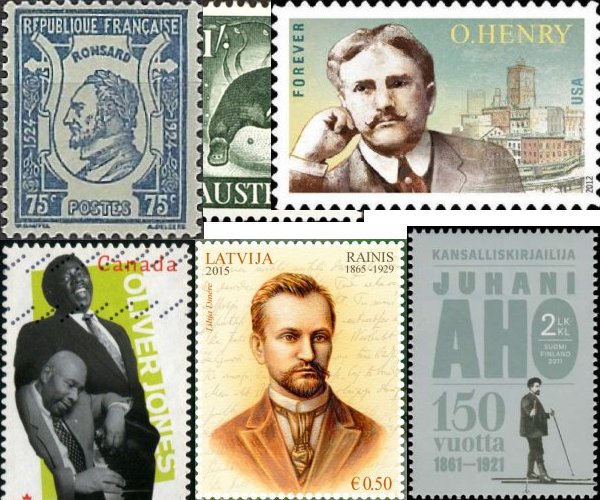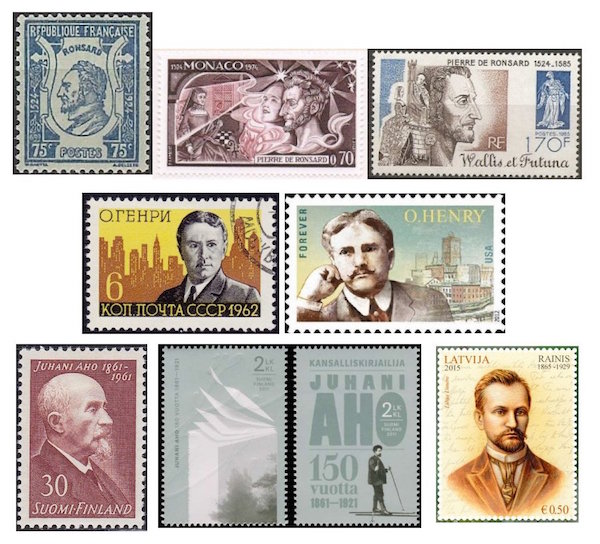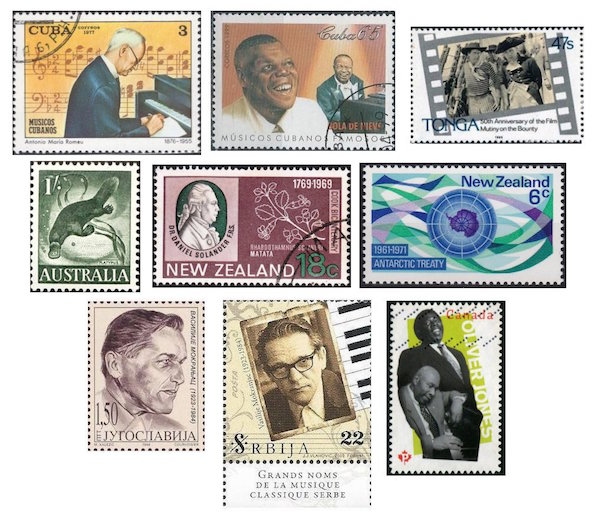The Arts on Stamps of the World — September 11
An Arts Fuse regular feature: the arts on stamps of the world.

By Doug Briscoe
September 11, a date sadly etched into our minds for the rest of our lifetimes, happens also to be the birthday of Pierre de Ronsard and O. Henry, along with numerous other arts-related figures who have been memorialized on stamps. Also, it’s the one hundredth anniversary of the birth of the fine Czech-born British screen actor Herbert Lom (11 September 1917 – 27 September 2012).
So just yesterday I was saying that the UK’s postal service has traditionally been lax in its representation of the country’s great artists on stamps, and as if to prove the point, there is, incredible as it may seem, no stamp for D. H. Lawrence (11 September 1885 – 2 March 1930), not from Britain, not from anywhere. Shame!
Speaking of philatelic curiosities, the Soviet Union issued a stamp for O. Henry (September 11, 1862 – June 5, 1910) fifty years before the United States did! A note about Cyrillic: in Russian there is no natural “H” sound, and for some reason H is replaced with G, so that, for example, Ernest Hemingway becomes Gemingvay, Hitler becomes Gitler, and O. Henry is spelled O. Genry. A number of explanations exist as to why William Sydney Porter chose the pen name O. Henry, so I won’t favor one over the others. He was born in Greensboro, North Carolina and lost his mother at the age of three. His father was a doctor, and Porter began work as a pharmacist while drawing sketches of the townsfolk. To seek a better climate for his cough he went to Texas, where he lived for the next twenty years. He put out a short-lived humorous weekly called The Rolling Stone that earned him a job at the Houston Post. Porter had also worked at a bank, among other things, and was accused of embezzlement in 1895. He went on the lam to New Orleans and Honduras but returned when he learned his wife was dying, as his mother did, of tuberculosis. He was sentenced to five years, but worked in the hospital wing, continued writing, and was released on good behavior after three. It was during this time that he came to be well known as “O. Henry”, one of several pseudonyms he had used. After moving to New York to be near his publisher, he wrote nearly 400 more stories. He fell victim to his own tendency to drink and died of cirrhosis and diabetes at 47. (His second wife also died of TB in 1927.)
The work of the “prince of poets” Pierre de Ronsard (1524 – 27 December 1585) was set by many composers even during his own lifetime (including Lassus, Janequin, Sweelinck, Arcadelt, and Anthoine de Bertrand). In the 19th century, songs to Ronsard were composed by Saint-Saëns, Bizet, Massenet, Wagner (!—an early 1839 song called “Mignonne”), and Théodore Gouvy (who penned a group of 40 Poèmes de Ronsard published in 1876); in the 20th by Ravel (“Ronsard à son âme“), Dukas, Poulenc, Roussel, Honegger, Milhaud, Ibert, Frank Martin, Ned Rorem, Hendrik Andriessen, and Louise Talma. In Richard Strauss’s opera Capriccio (1942), a poem attributed to the character Olivier (“Kein Andres, das mir so im Herzen loht“) is actually a loose translation by Hans Swarowsky of Ronsard’s “Je ne saurais aimer autre que vous.” Ronsard served as a page and then secretary at the Scottish court after the marriage of Madeleine of France to James V, but the sudden onset of deafness brought to a close his budding diplomatic career. After some years of study he made a success of his poetry and was taken up by French royalty. The blue French stamp at left is one of the oldest to commemorate a poet—it dates from 1924, the 400th anniversary of the poet’s birth and the same year in which Ravel, Dukas, and Roussel composed their Ronsard songs. (The same is true of Poulenc and Honegger, but they also composed other Ronsard settings in later years.)
We turn to a writer of a much later age, Juhani Aho, born in central Finland on this day in 1861. Originally Johannes Brofeldt, he adopted the pseudonym Juhani Aho while still at school. A writer of novels and short stories, he was in love with the woman who subsequently married Jean Sibelius, though he and the composer were to become close friends. Aho’s own work was taken up by composers, his novel Juha (1911) having been twice set as an opera, by his countrymen Aare Merikanto and Leevi Madetoja. He died in Helsinki on 8 August 1921. The stamps were made for his centenary in 1961 and sesquicentennial in 2011.

Yet another literary man was the Latvian poet and playwright Jānis Pliekšāns (September 11, 1865 – September 12, 1929), who used the pseudonym Rainis. His plays Fire and Night (1905) and Indulis and Arija (1911) are considered classics of Latvian theater. He also made a much admired translation of Goethe’s Faust. He was already making translations and writing poems while studying law at Saint Petersburg, and he continued writing while practicing in the courts. Pliekšāns edited a socialist newspaper until arrested by the Tsarist police and deported. It was during this internal exile that he crafted the Goethe translation and published his first poetry collection (1903). He worked for the 1905 Revolution and went into voluntary exile in Switzerland on its failure. There he wrote plays and more volumes of poetry. It was only in 1920 that he was able to return to a newly independent Latvia. He became involved in politics and hoped to become president, but this aspiration was never realized. He died the day after his 64th birthday. The stamp is quite new, from 2015.
Two Cuban pop music performers also share this birthday. Pianist, composer, and bandleader Antonio María Romeu Marrero (1876 – 18 January 1955) founded his own charanga (dance band) in 1910, which in the 30s developed briefly into a “big band”. Wikipedia tell us “His orchestra was Cuba’s leading charanga for over thirty years, specializing in the danzón“, of which Romeu composed some 500, some of them adapted from existing works.
Also a pianist, Ignacio Jacinto Villa Fernández (11 September 1911 – 2 October 1971) was also a singer and songwriter. He went by the stage name Bola de Nieve (Snowball). He played piano in silent movie theaters and accompanied the singer Rita Montaner, who had been married to Xavier Cugat, from 1933. Villa Fernández toured Europe and the Americas with his sophisticated cabaret style act that included songs in various languages. A friend of Andrés Segovia and Pablo Neruda, he supported Castro and was never persecuted despite his open homosexuality.
His name may not be so well known as those of Max Steiner, Miklós Rózsa, or Bernard Herrmann, but Herbert Stothart (September 11, 1885 – February 1, 1949) certainly belongs in the top rank of American film composers. Nominated a dozen times, he won a Best Original Score Oscar for The Wizard of Oz (the songs were by Yip Harburg and Harold Arlen). But besides that, just listen to a partial list of some of the classic films for which Stothart provided the music: Queen Christina (1933), The Barretts of Wimpole Street (1934), Anna Karenina (1935), A Night at the Opera (1935), A Tale of Two Cities (with Ronald Colman, 1935), After the Thin Man (1936), Pride and Prejudice (1940), Mrs. Miniver (1942), National Velvet (1944), and The Picture of Dorian Gray (with George Sanders, 1945). Stothart was born in Milwaukee and studied music in Europe. He wrote music for the stage and collaborated with Rudolf Friml on the 1924 operetta Rose-Marie. He was invited to Hollywood by Louis B. Mayer and worked there for the rest of his career. After suffering a heart attack in 1947 he wrote a symphonic poem about it. To honor him with a stamp, I selected one from the island kingdom of Tonga showing a still from one of Stothart’s other noteworthy projects, the 1935 Mutiny on the Bounty.

Born in Norwich, England, the artist Dame Eileen Mayo (11 September 1906 – 4 January 1994) emigrated to Australia in 1952 and settled in New Zealand ten years later. An explorer of virtually every medium, she produced drawings, murals, posters, book illustrations, woodcuts, lithographs, calligraphy, and tapestries. Some of the illustrations were for her own books on natural history. Although Mayo has not herself been the subject of a stamp, she designed a number of them for both Australia and New Zealand, of which I show three.
The family of Vasilije Mokranjac (vah-SEEL-ye mo-KRAHN-yahts, 1923 – Belgrade, 27 May 1984) was a musical one, both his parents having been cellists and his uncle Stevan Stojanović Mokranjac a composer. Vasilije devoted most of his life to teaching and was President of the Association of Serbian Composers in the early 60s. His compositions are exclusively instrumental and include five symphonies, piano pieces, and music for film. For reasons that remain obscure, he took his own life by leaping from his apartment window in 1984. He has stamps issued by Yugoslavia and Serbia.
Finally today we salute jazz pianist Oliver Jones, who was born in Montreal on September 11, 1934 and is thus celebrating his 83rd birthday. His parents were from Barbados, and Jones was performing in childhood even before taking lessons with Oscar Peterson’s sister Daisy Peterson Sweeney. Also an organist, composer, and arranger, Jones has released two dozen albums since 1983. Canada issued an Oliver Jones stamp in 2013.
A graduate of the University of Massachusetts with a B.A. in English, Doug Briscoe worked in Boston classical music radio, at WCRB, WGBH, and WBUR, for about 25 years, beginning in 1977. He has the curious distinction of having succeeded Robert J. Lurtsema twice, first as host of WGBH’s weekday morning classical music program in 1993, then as host of the weekend program when Robert J.’s health failed in 2000. Doug also wrote liner notes for several of the late Gunther Schuller’s GM Recordings releases as well as program notes for the Boston Classical Orchestra. For the past few years he’s been posting a Facebook “blog” of classical music on stamps of the world, which has now been expanded to encompass all the arts for The Arts Fuse.
